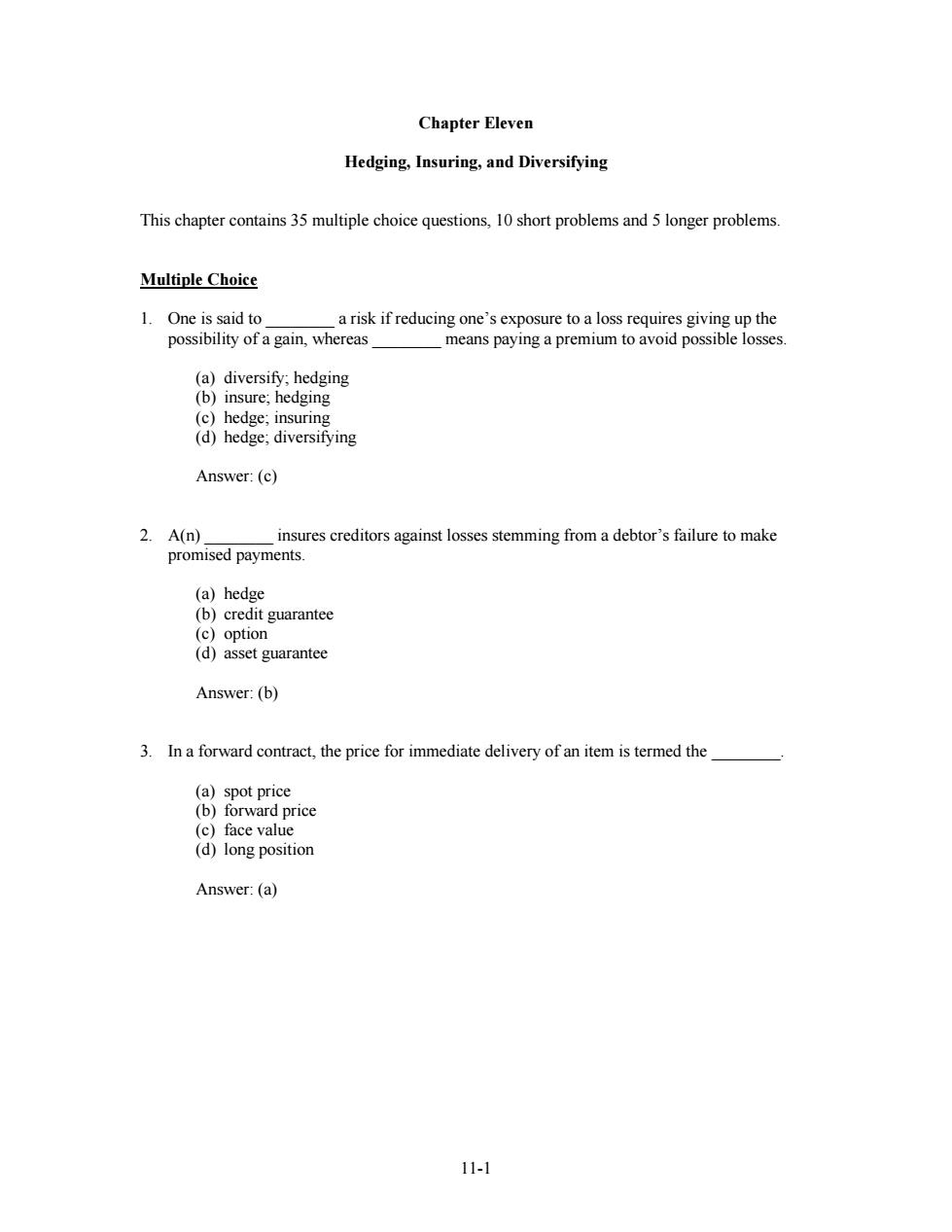
Chapter Eleven Hedging,Insuring,and Diversifying This chapter contains 35 multiple choice questions,10 short problems and 5 longer problems. Multiple Choice 1.One is said to a risk if reducing one's exposure to a loss requires giving up the possibility of a gain,whereas _means paying a premium to avoid possible losses. (a)diversify;hedging (b)insure;hedging (c)hedge;insuring (d)hedge;diversifying Answer:(c) 2.A(n) insures creditors against losses stemming from a debtor's failure to make promised payments. (a)hedge (b)credit guarantee (c)option (d)asset guarantee Answer:(b) 3.In a forward contract,the price for immediate delivery of an item is termed the (a)spot price (b)forward price (c)face value (d)long position Answer:(a) 11-1
11-1 Chapter Eleven Hedging, Insuring, and Diversifying This chapter contains 35 multiple choice questions, 10 short problems and 5 longer problems. Multiple Choice 1. One is said to ________ a risk if reducing one’s exposure to a loss requires giving up the possibility of a gain, whereas ________ means paying a premium to avoid possible losses. (a) diversify; hedging (b) insure; hedging (c) hedge; insuring (d) hedge; diversifying Answer: (c) 2. A(n) ________ insures creditors against losses stemming from a debtor’s failure to make promised payments. (a) hedge (b) credit guarantee (c) option (d) asset guarantee Answer: (b) 3. In a forward contract, the price for immediate delivery of an item is termed the ________. (a) spot price (b) forward price (c) face value (d) long position Answer: (a)
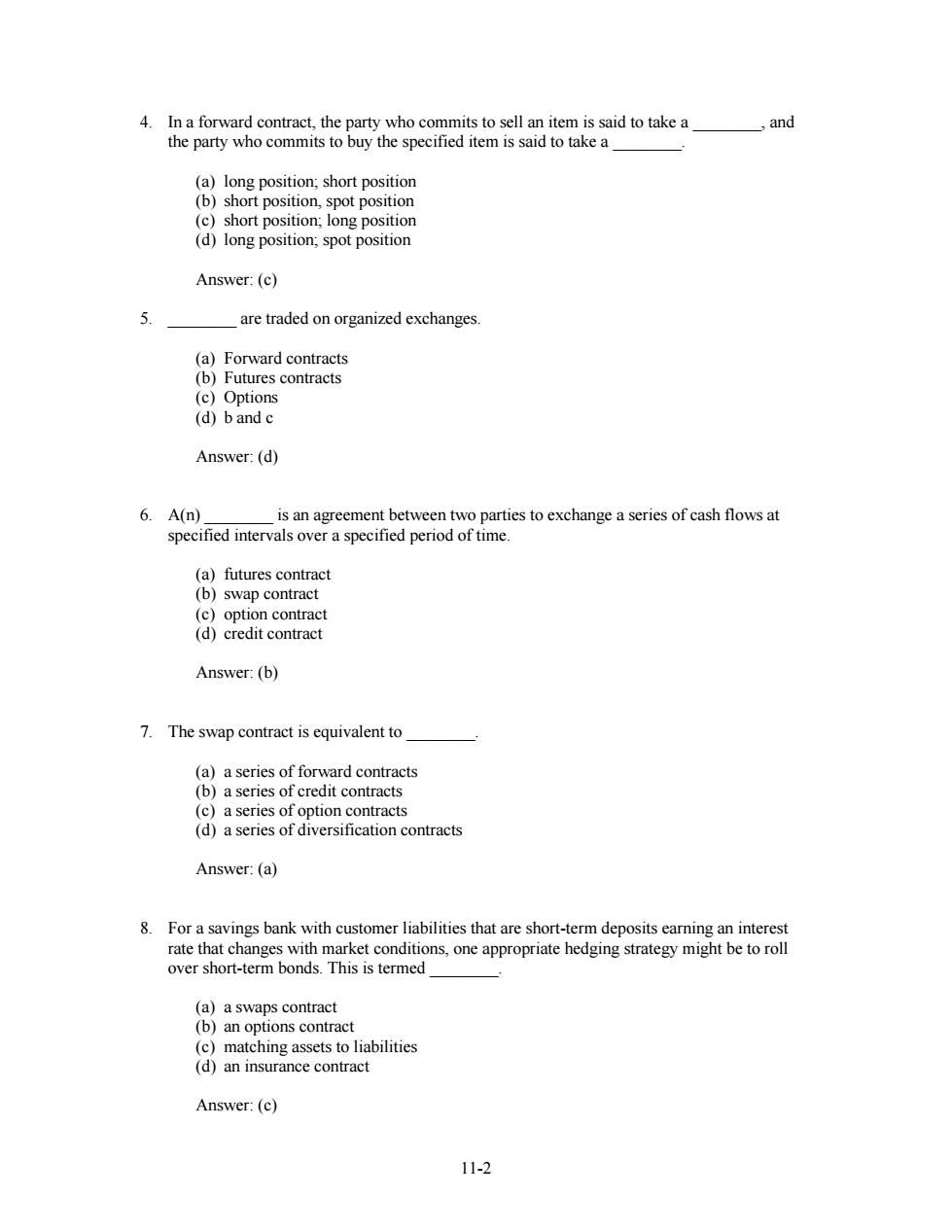
4.In a forward contract,the party who commits to sell an item is said to take a,and the party who commits to buy the specified item is said to take a (a)long position;short position (b)short position,spot position (c)short position;long position (d)long position;spot position Answer:(c) 5. are traded on organized exchanges. (a)Forward contracts (b)Futures contracts (c)Options (d)b and c Answer:(d) 6.A(n) is an agreement between two parties to exchange a series of cash flows at specified intervals over a specified period of time. (a)futures contract (b)swap contract (c)option contract (d)credit contract Answer:(b) 7.The swap contract is equivalent to (a)a series of forward contracts (b)a series of credit contracts (c)a series of option contracts (d)a series of diversification contracts Answer:(a) 8.For a savings bank with customer liabilities that are short-term deposits earning an interest rate that changes with market conditions,one appropriate hedging strategy might be to roll over short-term bonds.This is termed (a)a swaps contract (b)an options contract (c)matching assets to liabilities (d)an insurance contract Answer:(c) 11-2
11-2 4. In a forward contract, the party who commits to sell an item is said to take a ________, and the party who commits to buy the specified item is said to take a ________. (a) long position; short position (b) short position, spot position (c) short position; long position (d) long position; spot position Answer: (c) 5. ________ are traded on organized exchanges. (a) Forward contracts (b) Futures contracts (c) Options (d) b and c Answer: (d) 6. A(n) ________ is an agreement between two parties to exchange a series of cash flows at specified intervals over a specified period of time. (a) futures contract (b) swap contract (c) option contract (d) credit contract Answer: (b) 7. The swap contract is equivalent to ________. (a) a series of forward contracts (b) a series of credit contracts (c) a series of option contracts (d) a series of diversification contracts Answer: (a) 8. For a savings bank with customer liabilities that are short-term deposits earning an interest rate that changes with market conditions, one appropriate hedging strategy might be to roll over short-term bonds. This is termed ________. (a) a swaps contract (b) an options contract (c) matching assets to liabilities (d) an insurance contract Answer: (c)
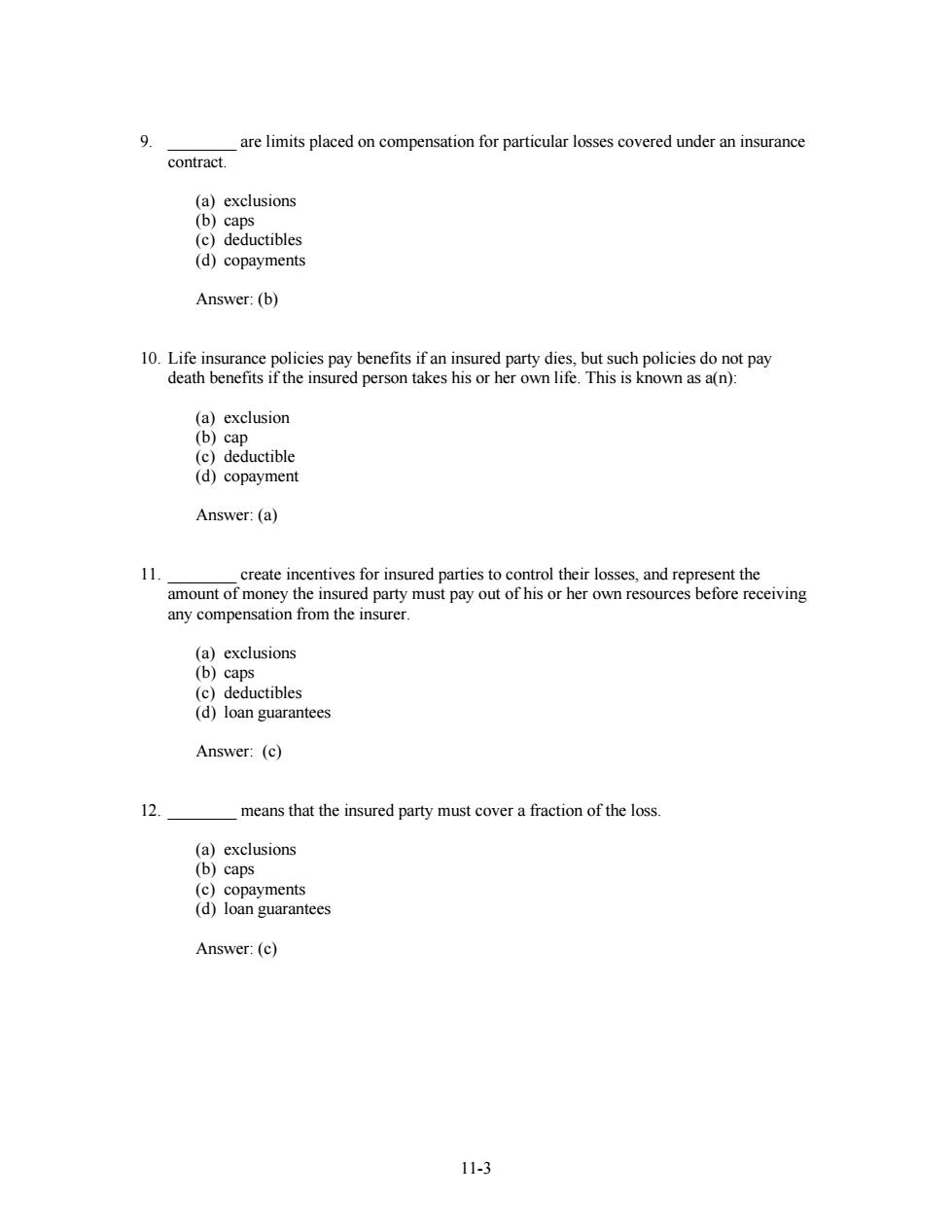
9 are limits placed on compensation for particular losses covered under an insurance contract. (a)exclusions (b)caps (c)deductibles (d)copayments Answer:(b) 10.Life insurance policies pay benefits if an insured party dies,but such policies do not pay death benefits if the insured person takes his or her own life.This is known as a(n): (a)exclusion (b)cap (c)deductible (d)copayment Answer:(a) 11. create incentives for insured parties to control their losses,and represent the amount of money the insured party must pay out of his or her own resources before receiving any compensation from the insurer. (a)exclusions (b)caps (c)deductibles (d)loan guarantees Answer:(c) 12. means that the insured party must cover a fraction of the loss. (a)exclusions (b)caps (c)copayments (d)loan guarantees Answer:(c) 11-3
11-3 9. ________ are limits placed on compensation for particular losses covered under an insurance contract. (a) exclusions (b) caps (c) deductibles (d) copayments Answer: (b) 10. Life insurance policies pay benefits if an insured party dies, but such policies do not pay death benefits if the insured person takes his or her own life. This is known as a(n): (a) exclusion (b) cap (c) deductible (d) copayment Answer: (a) 11. ________ create incentives for insured parties to control their losses, and represent the amount of money the insured party must pay out of his or her own resources before receiving any compensation from the insurer. (a) exclusions (b) caps (c) deductibles (d) loan guarantees Answer: (c) 12. ________ means that the insured party must cover a fraction of the loss. (a) exclusions (b) caps (c) copayments (d) loan guarantees Answer: (c)

13.A(n) is a contract that obliges the guarantor to make the promised payment on a loan if the borrower fails to do so. (a)exclusion (b)loan guarantee (c)copayment (d)interest-rate cap Answer:(b) 14.An interest rate insurance policy which guarantees a maximum interest rate is known as,or takes the form of (a)loan guarantee (b)interest-rate guarantee (c)interest-rate floor (d)interest-rate cap Answer:(d) 15. protect against losses from a decline in stock prices. (a)Expiration options (b)Call options (c)Put options (d)Strike options Answer:(c) 16.The is the fixed price specified in an option contract. (a)strike price (b)exercise price (c)spot price (d)a and b Answer:(d) 17.A(n) is the right,but not the obligation,to buy or sell something at an exercise price in the future. (a)forward contract (b)option (c)swap (d)deductible Answer:(b) 11-4
11-4 13. A(n) ________ is a contract that obliges the guarantor to make the promised payment on a loan if the borrower fails to do so. (a) exclusion (b) loan guarantee (c) copayment (d) interest-rate cap Answer: (b) 14. An interest rate insurance policy which guarantees a maximum interest rate is known as, or takes the form of ________. (a) loan guarantee (b) interest-rate guarantee (c) interest-rate floor (d) interest-rate cap Answer: (d) 15. ________ protect against losses from a decline in stock prices. (a) Expiration options (b) Call options (c) Put options (d) Strike options Answer: (c) 16. The ________ is the fixed price specified in an option contract. (a) strike price (b) exercise price (c) spot price (d) a and b Answer: (d) 17. A(n) ________ is the right, but not the obligation, to buy or sell something at an exercise price in the future. (a) forward contract (b) option (c) swap (d) deductible Answer: (b)

18.A(n) can be exercised on the expiration date only,whereas a(n) can be exercised at any time up to and including the expiration date. (a)American-type option;European-type option (b)European-type option;American-type option (c)European-type option;Asian-type option (d)American-type option;Asian-type option Answer:(b) 19.You are the Chief Financial Officer of a soybean oil company.In your job you receive dozens of different proposals each month regarding ways to hedge the company's exposure to falling soybean oil prices.How do you decide among the different proposals? (a)Choose the hedge with the best investment bank participating. (b)Choose the hedge that achieves the desired reduction in risk through the best insurance policy. (c)Choose the hedge that minimizes the cost of achieving the desired reduction in risk. (d)none of the above Answer:(c) 20.Which of the following are ways to avoid losses through insuring? (a)Lock in a fifteen hundred dollar fare for a holiday airfare. (b)Agree to purchase an apartment in six months for three hundred thousand dollars. (c)As a soybean grower,enter into a forward contract to sell your soybeans at a fixed price in a month. (d)none of the above Answer:(d) 21.Which of the following are ways to avoid losses through hedging? (a)Pay a premium for healthcare coverage. (b)Purchase a put option on a stock you do own. (c)Pay for a credit guarantee on a loan you are worried about collecting. (d)Enter into a swap to exchange a series of cash flows at specified intervals over a specified period of time. Answer:(d) 11-5
11-5 18. A(n) ________ can be exercised on the expiration date only, whereas a(n) ________ can be exercised at any time up to and including the expiration date. (a) American-type option; European-type option (b) European-type option; American-type option (c) European-type option; Asian-type option (d) American-type option; Asian-type option Answer: (b) 19. You are the Chief Financial Officer of a soybean oil company. In your job you receive dozens of different proposals each month regarding ways to hedge the company’s exposure to falling soybean oil prices. How do you decide among the different proposals? (a) Choose the hedge with the best investment bank participating. (b) Choose the hedge that achieves the desired reduction in risk through the best insurance policy. (c) Choose the hedge that minimizes the cost of achieving the desired reduction in risk. (d) none of the above Answer: (c) 20. Which of the following are ways to avoid losses through insuring? (a) Lock in a fifteen hundred dollar fare for a holiday airfare. (b) Agree to purchase an apartment in six months for three hundred thousand dollars. (c) As a soybean grower, enter into a forward contract to sell your soybeans at a fixed price in a month. (d) none of the above Answer: (d) 21. Which of the following are ways to avoid losses through hedging? (a) Pay a premium for healthcare coverage. (b) Purchase a put option on a stock you do own. (c) Pay for a credit guarantee on a loan you are worried about collecting. (d) Enter into a swap to exchange a series of cash flows at specified intervals over a specified period of time. Answer: (d)

22.Which of the following are ways to avoid losses through insuring? (a)Pay a premium for health care coverage (b)Purchase a put option on a stock you do own (c)Both a and b (d)Neither a nor b Answer:(c) Questions 23-25 refer to the following information: An old college friend of your invests in cocoa futures and options contracts.He has told you that he believes cocoa prices are escalating.You decide to go ahead and purchase a call option on cocoa with a strike price of $0.80 per pound.That way,if cocoa prices go up,you can exercise the call,buy the cocoa and sell them at a higher spot price. Assume the price of an option on fifty thousand pounds is one thousand five hundred dollars,and you purchase six options for nine thousand dollars on three hundred thousand pounds. 23.What type of transaction is this for you? (a)hedged position (b)speculative (c)insured position (d)none of the above Answer:(b) 24.Calculate the downside risk in dollars and percentage terms. (a)$1,500:+100% (b)$1,500:-100% (c)$9,000;-100% (d)$9,000;+100% Answer:(c) 25.If the price increases to $0.85 cents per pound,how much would you net after paying for the options? (a)$15,000 (b)$13,500 (c)$9,000 (d)$6,000 Answer:(d) 11-6
11-6 22. Which of the following are ways to avoid losses through insuring? (a) Pay a premium for health care coverage (b) Purchase a put option on a stock you do own (c) Both a and b (d) Neither a nor b Answer: (c) Questions 23-25 refer to the following information: An old college friend of your invests in cocoa futures and options contracts. He has told you that he believes cocoa prices are escalating. You decide to go ahead and purchase a call option on cocoa with a strike price of $0.80 per pound. That way, if cocoa prices go up, you can exercise the call, buy the cocoa and sell them at a higher spot price. Assume the price of an option on fifty thousand pounds is one thousand five hundred dollars, and you purchase six options for nine thousand dollars on three hundred thousand pounds. 23. What type of transaction is this for you? (a) hedged position (b) speculative (c) insured position (d) none of the above Answer: (b) 24. Calculate the downside risk in dollars and percentage terms. (a) $1,500; +100% (b) $1,500; –100% (c) $9,000; –100% (d) $9,000; +100% Answer: (c) 25. If the price increases to $0.85 cents per pound, how much would you net after paying for the options? (a) $15,000 (b) $13,500 (c) $9,000 (d) $6,000 Answer: (d)

26.You are interested in taking a vacation to Yemen next year,but you are worried about the price of the trip.Over the past three years,the price of a trip to Yemen has ranged between $3,500 and $4,500.The current price is $4,000.You wish to maintain the possibility of a lower price.How would you eliminate the possibility of rising prices,but still maintain the possibility of a gain from lower prices? (a)Purchase an option today from the sponsor,which would allow you to pay the lower of $4,000 or the market price at the time you take your Yemen vacation. (b)Purchase an option today from the sponsor,which would allow you to pay the higher of $4,000 or the market price at the time you take your vacation to Yemen. (c)Leave it to the market. (d)Arrange a futures contract through the newspaper. Answer:(a) Questions 27-30 refer to the following information. You are Chief Financial Officer of GreenShrimp and you purchase a large quantity of coffee each month.You are concerned about the price of coffee one month from now. You want to guarantee that you will not pay more than $1.60 per pound for fifty thousand pounds.You do not want to pay for insurance,but you do want to lock in a price of $1.60 per pound for fifty thousand pounds. 27.What is the economics of a futures transaction if the spot price on delivery date is $1.35? (a)Cost of coffee purchased from supplier=$67,500;cash flow from futures contract= $12,500 paid by GreenShrimp;total outlay =$80,000 (b)Cost of coffee purchased from supplier =$67,500;cash flow from futures contract $12,500 paid to GreenShrimp;total outlay =$55,000 (c)Cost of coffee purchased from supplier =$80,000;cash flow from futures contract= $0 paid to GreenShrimp;total $80,000 (d)Cost of coffee purchased from supplier=$80,000;cash flow from futures contract= $12,500 paid to GreenShrimp;total =$92,500 Answer:(a) 28.What is the economics of a futures transaction if the spot price on delivery date is $1.80? (a)Cost of coffee purchased from supplier =$62,500;cash flow from futures contract $12,500 paid by GreenShrimp;total outlay=$80,000 (b)Cost of coffee purchased from supplier=$80,000;cash flow from futures contract= $0 paid by GreenShrimp;total outlay =$80,000 (c)Cost of coffee purchased from supplier =$90,000;cash flow from futures contract= $10,000 paid to GreenShrimp;total outlay =$80,000 (d)Cost of coffee purchased from supplier $90,000;cash flow from futures contract $10,000 paid by GreenShrimp;total outlay=$100,000 Answer:(c) 11-7
11-7 26. You are interested in taking a vacation to Yemen next year, but you are worried about the price of the trip. Over the past three years, the price of a trip to Yemen has ranged between $3,500 and $4,500. The current price is $4,000. You wish to maintain the possibility of a lower price. How would you eliminate the possibility of rising prices, but still maintain the possibility of a gain from lower prices? (a) Purchase an option today from the sponsor, which would allow you to pay the lower of $4,000 or the market price at the time you take your Yemen vacation. (b) Purchase an option today from the sponsor, which would allow you to pay the higher of $4,000 or the market price at the time you take your vacation to Yemen. (c) Leave it to the market. (d) Arrange a futures contract through the newspaper. Answer: (a) Questions 27-30 refer to the following information. You are Chief Financial Officer of GreenShrimp and you purchase a large quantity of coffee each month. You are concerned about the price of coffee one month from now. You want to guarantee that you will not pay more than $1.60 per pound for fifty thousand pounds. You do not want to pay for insurance, but you do want to lock in a price of $1.60 per pound for fifty thousand pounds. 27. What is the economics of a futures transaction if the spot price on delivery date is $1.35? (a) Cost of coffee purchased from supplier = $67,500; cash flow from futures contract = $12,500 paid by GreenShrimp; total outlay = $80,000 (b) Cost of coffee purchased from supplier = $67,500; cash flow from futures contract = $12,500 paid to GreenShrimp; total outlay = $55,000 (c) Cost of coffee purchased from supplier = $80,000; cash flow from futures contract = $0 paid to GreenShrimp; total = $80,000 (d) Cost of coffee purchased from supplier = $80,000; cash flow from futures contract = $12,500 paid to GreenShrimp; total =$92,500 Answer: (a) 28. What is the economics of a futures transaction if the spot price on delivery date is $1.80? (a) Cost of coffee purchased from supplier = $62,500; cash flow from futures contract = $12,500 paid by GreenShrimp; total outlay = $80,000 (b) Cost of coffee purchased from supplier = $80,000; cash flow from futures contract = $0 paid by GreenShrimp; total outlay = $80,000 (c) Cost of coffee purchased from supplier = $90,000; cash flow from futures contract = $10,000 paid to GreenShrimp; total outlay = $80,000 (d) Cost of coffee purchased from supplier = $90,000; cash flow from futures contract = $10,000 paid by GreenShrimp; total outlay = $100,000 Answer: (c)
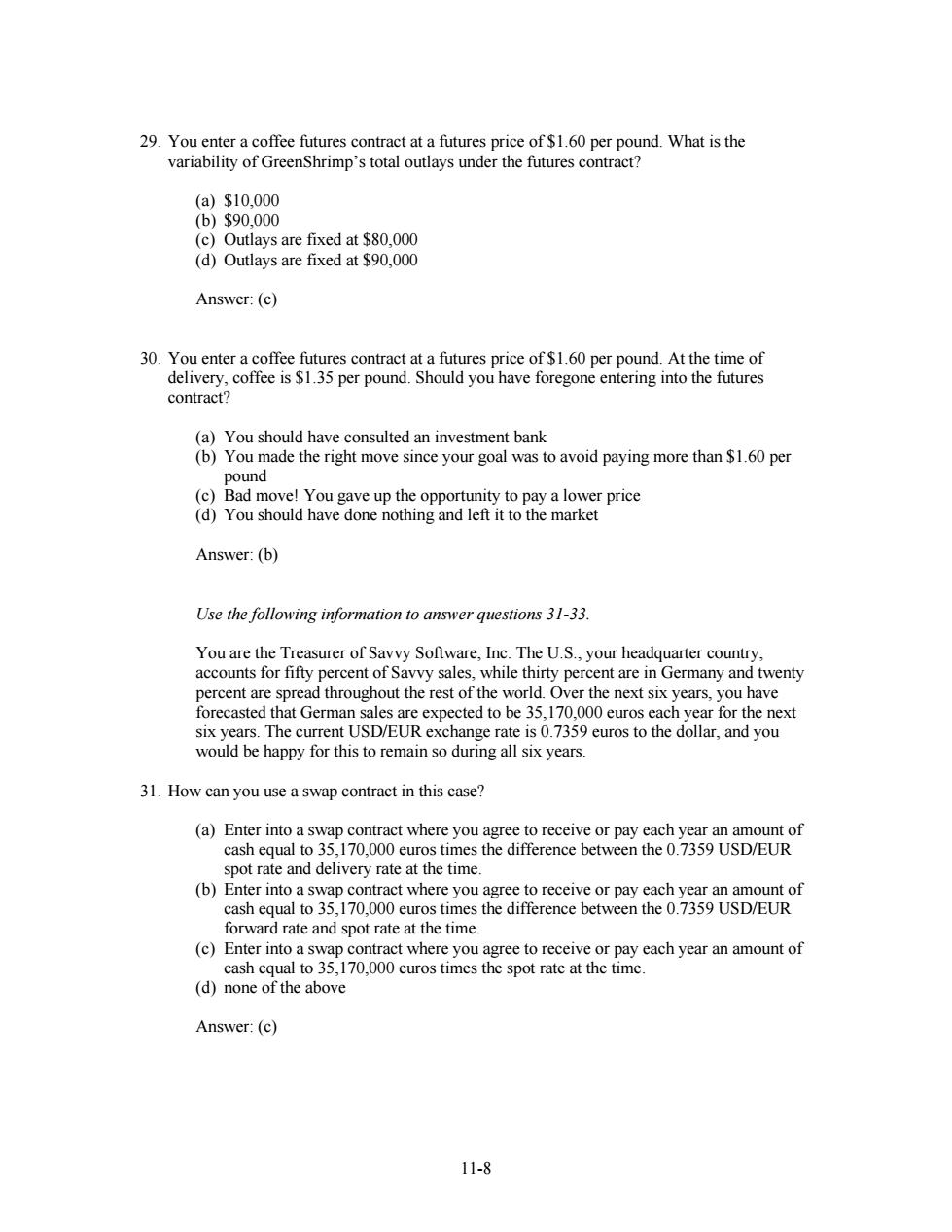
29.You enter a coffee futures contract at a futures price of $1.60 per pound.What is the variability of GreenShrimp's total outlays under the futures contract? (a)$10,000 (b)$90.000 (c)Outlays are fixed at $80,000 (d)Outlays are fixed at $90,000 Answer:(c) 30.You enter a coffee futures contract at a futures price of $1.60 per pound.At the time of delivery,coffee is $1.35 per pound.Should you have foregone entering into the futures contract? (a)You should have consulted an investment bank (b)You made the right move since your goal was to avoid paying more than $1.60 per pound (c)Bad move!You gave up the opportunity to pay a lower price (d)You should have done nothing and left it to the market Answer:(b) Use the following information to answer questions 31-33. You are the Treasurer of Savvy Software,Inc.The U.S.,your headquarter country, accounts for fifty percent of Savvy sales,while thirty percent are in Germany and twenty percent are spread throughout the rest of the world.Over the next six years,you have forecasted that German sales are expected to be 35,170,000 euros each year for the next six years.The current USD/EUR exchange rate is 0.7359 euros to the dollar,and you would be happy for this to remain so during all six years. 31.How can you use a swap contract in this case? (a)Enter into a swap contract where you agree to receive or pay each year an amount of cash equal to 35,170,000 euros times the difference between the 0.7359 USD/EUR spot rate and delivery rate at the time. (b)Enter into a swap contract where you agree to receive or pay each year an amount of cash equal to 35,170,000 euros times the difference between the 0.7359 USD/EUR forward rate and spot rate at the time. (c)Enter into a swap contract where you agree to receive or pay each year an amount of cash equal to 35,170,000 euros times the spot rate at the time. (d)none of the above Answer:(c) 11-8
11-8 29. You enter a coffee futures contract at a futures price of $1.60 per pound. What is the variability of GreenShrimp’s total outlays under the futures contract? (a) $10,000 (b) $90,000 (c) Outlays are fixed at $80,000 (d) Outlays are fixed at $90,000 Answer: (c) 30. You enter a coffee futures contract at a futures price of $1.60 per pound. At the time of delivery, coffee is $1.35 per pound. Should you have foregone entering into the futures contract? (a) You should have consulted an investment bank (b) You made the right move since your goal was to avoid paying more than $1.60 per pound (c) Bad move! You gave up the opportunity to pay a lower price (d) You should have done nothing and left it to the market Answer: (b) Use the following information to answer questions 31-33. You are the Treasurer of Savvy Software, Inc. The U.S., your headquarter country, accounts for fifty percent of Savvy sales, while thirty percent are in Germany and twenty percent are spread throughout the rest of the world. Over the next six years, you have forecasted that German sales are expected to be 35,170,000 euros each year for the next six years. The current USD/EUR exchange rate is 0.7359 euros to the dollar, and you would be happy for this to remain so during all six years. 31. How can you use a swap contract in this case? (a) Enter into a swap contract where you agree to receive or pay each year an amount of cash equal to 35,170,000 euros times the difference between the 0.7359 USD/EUR spot rate and delivery rate at the time. (b) Enter into a swap contract where you agree to receive or pay each year an amount of cash equal to 35,170,000 euros times the difference between the 0.7359 USD/EUR forward rate and spot rate at the time. (c) Enter into a swap contract where you agree to receive or pay each year an amount of cash equal to 35,170,000 euros times the spot rate at the time. (d) none of the above Answer: (c)
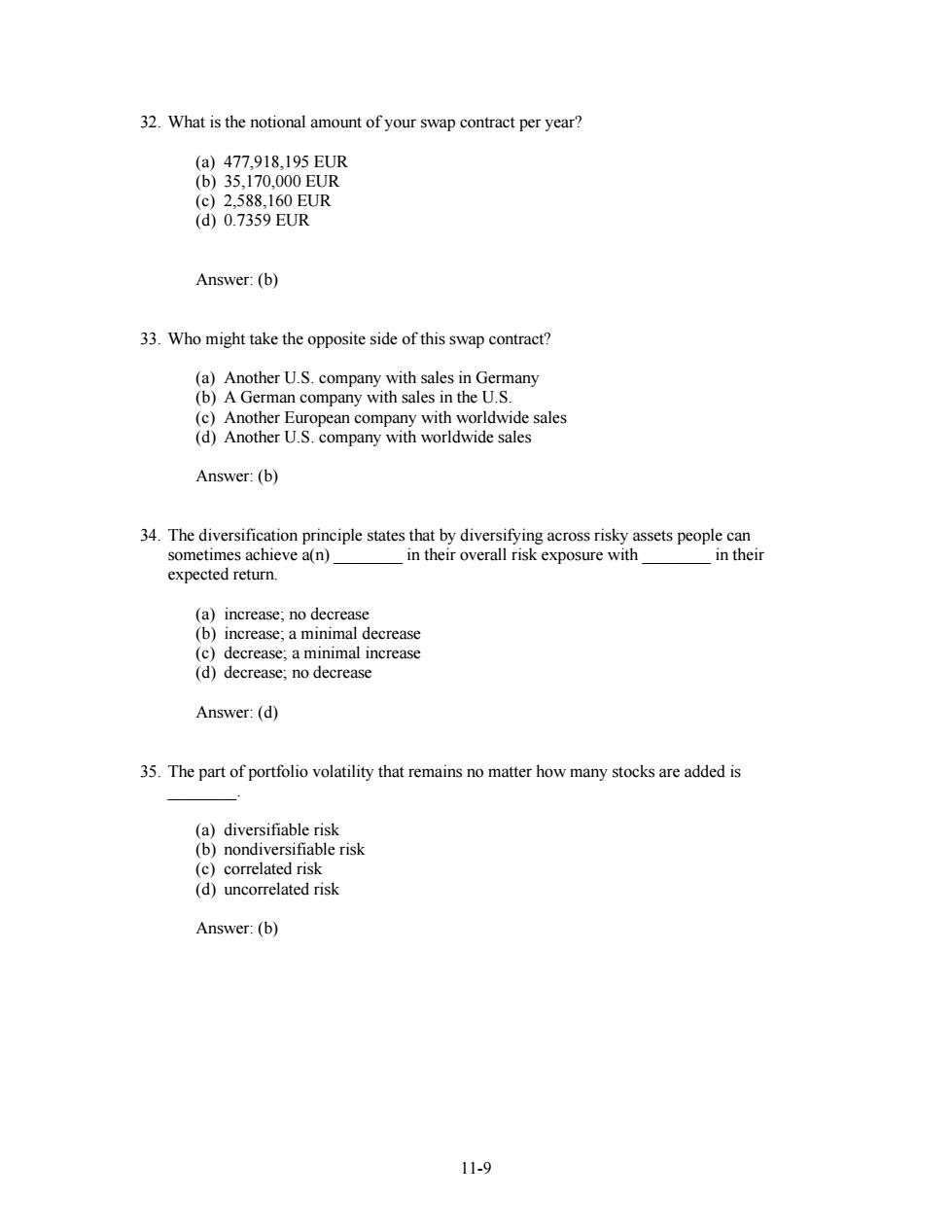
32.What is the notional amount of your swap contract per year? (a)477,918,195EUR (b)35,170,000EUR (c)2,588,160EUR (d)0.7359EUR Answer:(b) 33.Who might take the opposite side of this swap contract? (a)Another U.S.company with sales in Germany (b)A German company with sales in the U.S. (c)Another European company with worldwide sales (d)Another U.S.company with worldwide sales Answer:(b) 34.The diversification principle states that by diversifying across risky assets people can sometimes achieve a(n) in their overall risk exposure with in their expected return. (a)increase;no decrease (b)increase;a minimal decrease (c)decrease;a minimal increase (d)decrease:no decrease Answer:(d) 35.The part of portfolio volatility that remains no matter how many stocks are added is (a)diversifiable risk (b)nondiversifiable risk (c)correlated risk (d)uncorrelated risk Answer:(b) 11-9
11-9 32. What is the notional amount of your swap contract per year? (a) 477,918,195 EUR (b) 35,170,000 EUR (c) 2,588,160 EUR (d) 0.7359 EUR Answer: (b) 33. Who might take the opposite side of this swap contract? (a) Another U.S. company with sales in Germany (b) A German company with sales in the U.S. (c) Another European company with worldwide sales (d) Another U.S. company with worldwide sales Answer: (b) 34. The diversification principle states that by diversifying across risky assets people can sometimes achieve a(n) ________ in their overall risk exposure with ________ in their expected return. (a) increase; no decrease (b) increase; a minimal decrease (c) decrease; a minimal increase (d) decrease; no decrease Answer: (d) 35. The part of portfolio volatility that remains no matter how many stocks are added is ________. (a) diversifiable risk (b) nondiversifiable risk (c) correlated risk (d) uncorrelated risk Answer: (b)

Short Problems 1.Describe the main features of forwards contracts.How do forwards contracts differ from futures contracts? Answer: Main features offorwards contracts: ● Two parties agree to exchange some item in the future at a price specified now-this specified price is called the forward price. The spot price is the price for immediate delivery of the item. No money is paid in the present by either party to the other. The face value of the contract is the quantity of the item specified in the contract multiplied by the forward price. The party who commits to buy the specified item is said to take a long position and the party who commits to sell the item is said to take a short position. A futures contract is essentially a standardized forward contract that is traded on an organized exchange.The exchange interposes itself between the buyer and the seller,so that each has a separate contract with the exchange.Standardization means that the terms of the futures contract are the same for all contracts. 11-10
11-10 Short Problems 1. Describe the main features of forwards contracts. How do forwards contracts differ from futures contracts? Answer: Main features of forwards contracts: Two parties agree to exchange some item in the future at a price specified now – this specified price is called the forward price. The spot price is the price for immediate delivery of the item. No money is paid in the present by either party to the other. The face value of the contract is the quantity of the item specified in the contract multiplied by the forward price. The party who commits to buy the specified item is said to take a long position and the party who commits to sell the item is said to take a short position. A futures contract is essentially a standardized forward contract that is traded on an organized exchange. The exchange interposes itself between the buyer and the seller, so that each has a separate contract with the exchange. Standardization means that the terms of the futures contract are the same for all contracts